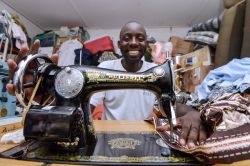Meni Mbugha brings pygmy style to city life in DR Congo

Mbugha, 33, creates dresses, skirts, tops, jackets and scarves bearing the floral patterns, stippled lines and curvy flourishes that the ethnic minority people living in the Democratic Republic of Congo traditionally carve into bark.
With his painstaking work on white linen, which is piled up in his studio, Mbugha has set out to highlight the beauty of the age-old art of the pygmies, who tend to be treated with contempt by those who consider themselves less primitive.
The artist uses original pygmy bark paintings of the flora and fauna they know so well to inspire his work, which begins with draft designs on a computer before he embarks on silkscreen prints for his collection Protos, which means “first” in Greek. He has a beige bag to carry samples of his craft.
Mbugha was born in the eastern French town of Nancy to a nutritionist father and a mother whose main tasks in life were caring for the house and raising four children. He was six when the family flew back to live in their native land, then called Zaire.
A gifted dancer, Mbugha upset his parents when he told them he wanted to study fashion design. “My father said that was a school for girls, that I would end up sitting under a tree stitching clothes for women,” the soft-spoken man said with a gentle smile.
– ‘Fashion, forest protection’ –
In fact, the young man spent three years studying information technology, then transferred to learn about fine art. Secretively, he started courses at the Higher Institute of Arts and Crafts (ISAM) in Kinshasa, where he said his “very ecologist” leanings led him to study “fashion and the protection of the forest”.
In 2007, he met a pygmy family from the Mbuti tribe living in the Epulu forest of northeastern DR Congo who had fled west to the capital to escape raids by militia forces in their troubled region.
It was when these friends gave him a photo album with pictures of pygmy drawings on bark that Mbugha found his future line of work. “I told myself, why not print these themes on tissues?”
He was well aware that deforestation and mining activities pose a considerable threat to the traditional hunter-gatherer lifestyle of the little people, whose communities are scattered across several countries in the central African rainforest, the second green lung of the planet after the Amazon.
Despite social progess, pygmies are confronted with obstacles when they seek to benefit from health care and education and they encounter frequent discrimination. They are exploited by people who make them work for derisory sums of money or for payment in kind, which can often mean alcohol and cigarettes, spreading addiction.
En 2011, Mbugha went for the first time to the Epulu forest itself, which has been listed a World Heritage site by the UN Educational, Scientific and Cultural Organisation (UNESCO). Epulu is renowned for its okapis, which look like a cross between a giraffe and a zebra and are now to be found only in northeast DR Congo.
While visiting pygmy villages, Mbugha observed that the Mbuti people “express their vision of the world on beaten pieces of tree bark according to a very particular philosophy and technique”, he wrote on a blog that recounts his travels in text and photos.
These pieces of bark, gathered by men from trees of the ficus variety akin to fig trees on other continents, are painted with dyes made from plants in black, red and yellow hues. The artists are women, who depict local wildlife in their work while children look on attentively.
– ‘Make money with knowledge’ –
The pygmies customarily use the drawings for ceremonial purposes, but they also sell them to tourists. “I said to myself that these indigenous people could use fabric in place of bark … and make money with their knowledge,” said Mbugha.
He hopes to turn this initiative to help pygmy people into a project called Ndura, meaning “forest” in the Kibila language of the northeast, and to get it off the ground by the end of this year.
Some of the money needed would be raised by sales of a new line of clothing named Vivuya, which means “beauty” in another northeastern language, Kinande. Mbugha launched the style in 2012 and it went down very well at the Kinshasa Fashion Week in July last year.
Next July, helped by the “modest income” he makes teaching at ISAM, Mbugha plans to put on a show at the French Cultural Institute in Kinshasa, along with another in Kisangani, the country’s third largest city and capital of Oriental Province, where Ebulu lies. Once these exhibitions are over, the artist wants to pay a return visit to the pygmies.

